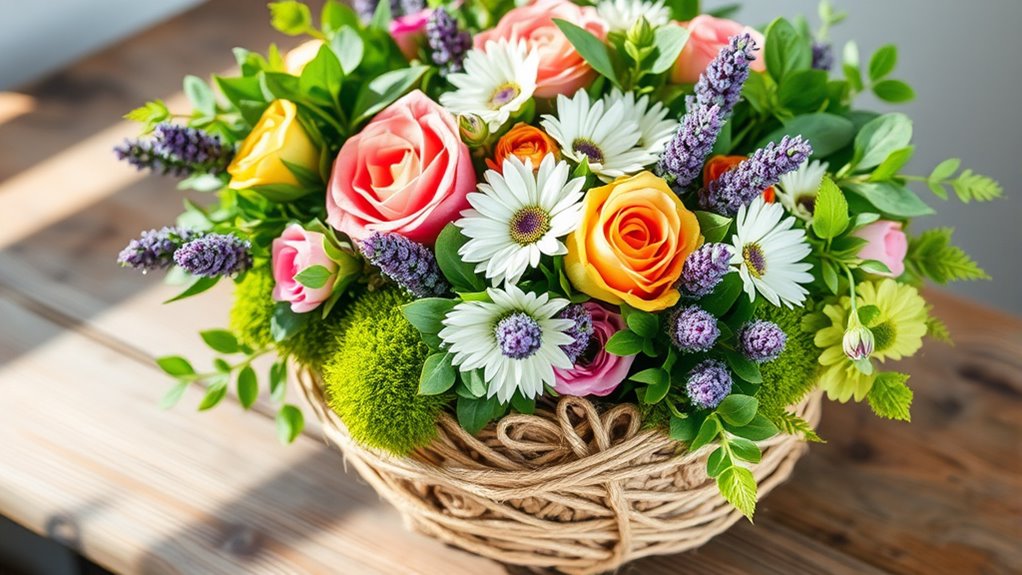To make your floral arrangements more eco-friendly, consider replacing traditional floral foam with natural options like chicken wire, floral netting, or crushed stone, which are reusable and biodegradable. Sphagnum moss and coconut coir also provide sustainable support without harming the environment. Using biodegradable containers and wrapping materials can further reduce waste. Want to explore additional eco-conscious ideas? Keep exploring to discover more sustainable floral solutions.
Key Takeaways
- Use reusable materials like chicken wire, floral netting, or crushed stone as sustainable foundations.
- Incorporate biodegradable options such as sphagnum moss, coconut coir, or plant-based gels for support.
- Opt for natural, biodegradable containers and wrapping materials like burlap, craft paper, or recycled packaging.
- Fill containers with water and floral preservatives to maintain freshness without relying on floral foam.
- Emphasize eco-conscious practices by selecting sustainable components and avoiding non-biodegradable plastics.

When it comes to creating stunning floral arrangements, floral foam often seems like the only option, but there are effective alternatives that you can use. If you’re aiming for eco-friendly designs, it’s essential to consider sustainable packaging and biodegradable materials that reduce environmental impact. Traditional floral foam, made from non-biodegradable plastics, contributes to landfill waste and can take centuries to decompose. Switching to greener options not only benefits the planet but also enhances your arrangements’ overall sustainability.
Creating eco-friendly floral arrangements by choosing biodegradable, sustainable packaging over traditional foam.
One popular alternative is chicken wire or floral netting. You can shape it to fit your container and create a sturdy base for your flowers. This method allows you to position stems securely without relying on foam. Plus, chicken wire is reusable; you can shape, cut, and store it for future projects. Another eco-friendly choice is using crushed stone or gravel, which provides a stable foundation and ensures the flowers stay upright. These materials are natural, inexpensive, and can be reused multiple times, aligning with sustainable packaging principles.
Another effective alternative involves wet floral foam substitutes like coconut coir or sphagnum moss. Coconut coir, made from the husk of coconuts, is a biodegradable material that retains water well, keeping flowers hydrated longer. Sphagnum moss, harvested sustainably, is also biodegradable and provides excellent support for stems. Both options are natural, compostable, and can be integrated seamlessly into arrangements, reducing reliance on synthetic foam. Research indicates that using biodegradable materials can significantly lessen environmental impact.
For a more innovative approach, consider using recycled or repurposed containers filled with water and floral preservatives. You can arrange flowers directly in these containers, which are often made from glass, metal, or recycled plastics—many of which are biodegradable or recyclable. This method eliminates the need for floral foam altogether, offering a truly sustainable packaging solution. Additionally, wrapping the stems in biodegradable materials like burlap or craft paper before inserting them into the container adds an extra layer of eco-consciousness.
Lastly, you might explore the use of plant-based gels or gels derived from biodegradable polymers. These are designed to hold water and support floral stems without the environmental drawbacks of traditional foam. Although they may be more costly, they provide a biodegradable alternative that aligns with eco-friendly practices.
Frequently Asked Questions
Are There Biodegradable Floral Foam Options Available?
You’re wondering if biodegradable floral foam options exist. Yes, sustainable floral design now offers biodegradable foam options that break down naturally, reducing environmental impact. These eco-friendly alternatives are made from materials like natural starches or plant-based substances, making them a great choice for eco-conscious arrangements. By choosing biodegradable foam options, you help promote sustainability in floral design while maintaining the stability and functionality you need for beautiful, eco-friendly arrangements.
How Long Do Eco-Friendly Alternatives Typically Last?
You might think eco-friendly alternatives for floral foam last forever, but sadly, they don’t. While they boast sustainable sourcing, their floral foam durability varies—some last only a few days, others up to two weeks. It’s a gentle reminder that even eco-conscious choices have limits. So, if you’re aiming for longevity, expect to refresh your arrangements more often. Real sustainability balances durability with eco-friendliness, after all.
Can These Alternatives Support Heavy or Large Floral Arrangements?
You might wonder if eco-friendly alternatives can handle heavy or large floral arrangements. These options often provide good support, but their ability for heavy support and large arrangement stability varies. For heavier or grander displays, consider using sturdier materials like chicken wire, moss, or biodegradable oasis, which can securely hold large blooms. Always test your chosen support to make certain your arrangement remains stable and visually appealing.
Are Eco-Friendly Floral Foam Substitutes Cost-Effective?
They say “you get what you pay for,” but eco-friendly floral foam substitutes can be surprisingly cost-effective. By choosing sustainable packaging and eco-conscious sourcing, you reduce waste and support greener practices without breaking the bank. While some options may have a higher upfront cost, their durability and environmental benefits often lead to savings in the long run, making them a smart investment for your arrangements and the planet.
How Do I Properly Dispose of Biodegradable Floral Foam?
You should properly dispose of biodegradable floral foam by first allowing it to undergo the biodegradation process. You can do this by breaking it into smaller pieces and burying it in compost or soil, where it will naturally absorb water and decompose over time. This method guarantees the foam’s water absorption properties are utilized during biodegradation, making it an eco-friendly way to dispose of the foam without harming the environment.
Conclusion
By choosing eco-friendly alternatives, you gently steer your floral creations toward a greener future. Imagine your arrangements resting softly in natural materials, like a whisper of spring’s first breeze, inviting beauty without leaving a trace. Each thoughtful choice nurtures the earth’s delicate balance, allowing your artistry to bloom harmoniously with nature. Embrace these sustainable options, and let your floral designs become a tender reminder of the beauty we can preserve together.










